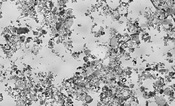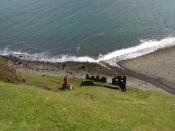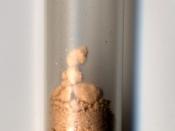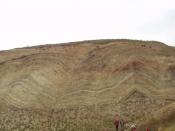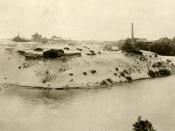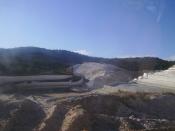DIATOMITE Diatomite is a sedimentary rock, that is white and yellowish in color. It is composed of fossilized skeletons of one-celled algae-like plants called diatoms. It is accumulated in marine areas. The Honeycomb sillia structure is useful because of its high absorptive capacity and surface area. It is also very chemically stable. Its principal use is filtration.
This substance of diatomite is extracted from many countries around the world. Out of 30 world countries the largest suppliers are the United States, China, Denmark, and Japan. China supplies about 350 thousand metric tons, Denmark extracts 375 thousand metric tons, and Japan, 190 thousand metric tons. About 725 thousand metric tons of diatomite are extracted from the US Worldwide about 2,150 thousand metric tons are removed from the earth.
This product consists of approximately 90 percent silica, and the remainder consists of compounds such as aluminum and iron oxides.
The material is extracted by a dredging barge cuts sediment with rotating knives, mixes it with water and pumps it along a suspended pipeline to the shore.
Because diatomite is made from a skeletal structure of diatoms, it isn't made of chemicals that need to be extracted. It is highly unreactive to other chemicals. It also has a low thermal conductivity rate and a high fusion point.
Most diatomite mines are open pit mines because the deposits are usually at or near the surface. Open pit mines are especially hard on the environment because they are very large holes in the ground.
Diatomite is also mined when geologic uplifting brings these deposits above sea level. The diatomite is easily mined this way, however, being in marine areas, pollution in the water is a big concern.
Through the use of many mining machines, the waters can be easily polluted. The method of dredging to cut away at the sediment does not seem like it would be as environmentally friendly as well. Aside from the mining having impact on the actual land, diatomite mining has impacts on birds in surrounding areas. Many birds show a tendency to avoid dredging areas. Besides factors of noise and pollution and general unpleasantness of machines, birds also rely on animals in shallow water for food where dredging has occurred.
Currently there are no recycling methods for diatomite. The eventual replacement of diatomite filters with membrane types may be speeded by legislation regarding waste disposal, which would make the option of dumping diatomite cake in landfill sites more expensive or even prohibited. One environmental specification of color is put on diatomite, because it is a calcine product. It has to be of a light whitish color or it is not available to be mined. This helps environmentally because the color determines a standard for what companies can and cannot mine.
I think one way for lessening the impact on the environment, would be to work harder at developing recycling methods for diatomite cake. If recycling could be put into use not as much diatomite would need to be mined. To excavate diatomite, different combinations of rippers, dozers, scrapers, front-end loaders, power shovels, and dump trucks are used. Underground mining is not too uncommon outside the United States. Usually, room-and-pillar methods are used, often with equipment similar to that used in open pits; in the smallest mines, hand tools are used. Dredging is used to recover diatomaceous mud from the bottom of lakes. Since all these methods are used in excavation, I think the best idea would be to choose the method with the least impact environmentally.
Sixty four percent of the diatomite mined is used in filtration.
Fourteen percent is used for absorbents, and twelve percent used in fillers. While two percent used for insulation, and eight percent used in other ways. Diatomite is principally used in filtration of various alcoholic beverages, sugar, oil, organic and inorganic chemicals, and water.
Many materials can be substituted for diatomite. Expanded perlite and silica sand compete for filtration purposes. Other filtration technologies use ceramic, polymeric, or carbon membrane. Alternate filler materials include talc, ground silica sand, ground mica, clay, perlite, vermiculite, and ground limestone. For thermal insulation materials such as various clays and special brick, mineral wool, expanded perlite, and exfoliated vermiculite can be used.
Conservation would mostly be attained through finding ways to recycle or more efficiently using the cake, or using substitutes for the material.
Diatomite is an excellent filtering material for many things.
Most commonly used in beverages, fruit juices, soft drinks, beer, and wine. It is used in chemicals like sodium hydroxide, sulfuric acid, and gold salts. Filtration of cooking oils, vegetable and animal, and sugars, cane, beet, and corn, is a popular use for diatomite. I think the most important use is filtration of water supplies like municipal, swimming pool, and waste. Other uses of diatomite are tied to varnishes, lacquers, jet fuels, and antibiotics, to name a few. The low abrasive properties make it suitable for use in toothpaste, "nonabrasive" cleansers, polishes (silver & automobile), and buffing compounds. Diatomite is widely used as a filler and extender in paint, paper, and rubber and even plastic products. The gloss and sheen of "flat" paints can be controlled using diatomite. During the manufacture of plastic bags, diatomite is added to the newly formed sheets to act as an anti-blocking agent so that the plastic (polyethylene) can be rolled while it is still hot. Even though all these uses are very practical and beneficial, the fact of the matter is that there are many substitutions for it. Diatomite could probably be eliminated by many replacements. However, the replacements could possibly be more harmful to the environment than diatomite mining.
I think that since diatomite is used for a great number of products, and one single product couldn't replace all of what it does, more damage could be done finding and mining these replacement products. Most of the materials that require diatomite in production are highly consumed products. A large growing application is as an absorbent for industrial spills such as oil and toxic liquids. If more highly beneficial uses such as cleaning toxic spills were discovered, mining would be very much worth the impact it leaves. It also has potential use as an insecticide. Instead of harsh chemicals that could be eaten by pets, diatomite kills insects in a different way. The silica wears down their exoskeletons, clogs their joins or blocks their spiracles and eventually kills them through dehydration and suffocation. I feel that diatomite itself is important as filtration, and also has potential in many different areas. I feel that mining of this product is worth the impact it leaves on the environment.
I was most likely taking diatomite for granted. I was not even aware that it was a product, let alone that it was useful in different ways. A lot of things I use daily would not be the same without the use of diatomite. I drink soda every day, and I would not get that drink if it were not filtered. I've never even wondered about how water in a swimming pool is filtered, yet if it were not, I'm positive swimming would not be as enjoyable in the summer. I like the fact that diatomite seems incredibly useful for very important things, such as toxic waste, antibiotics and water filtration. I also think it is exceptional because it goes to use for so many different products.
Some things that are mined can only go to a few things, whereas diatomite can go from cleaning toxins, to paint fillers, to filtering wine, to insecticides. I don't like diatomite for the fact that it is not being recycled, and that no recycling programs are being put into use right now. Overall I think that diatomite is a worthwhile product and beneficial to consumers every day.
